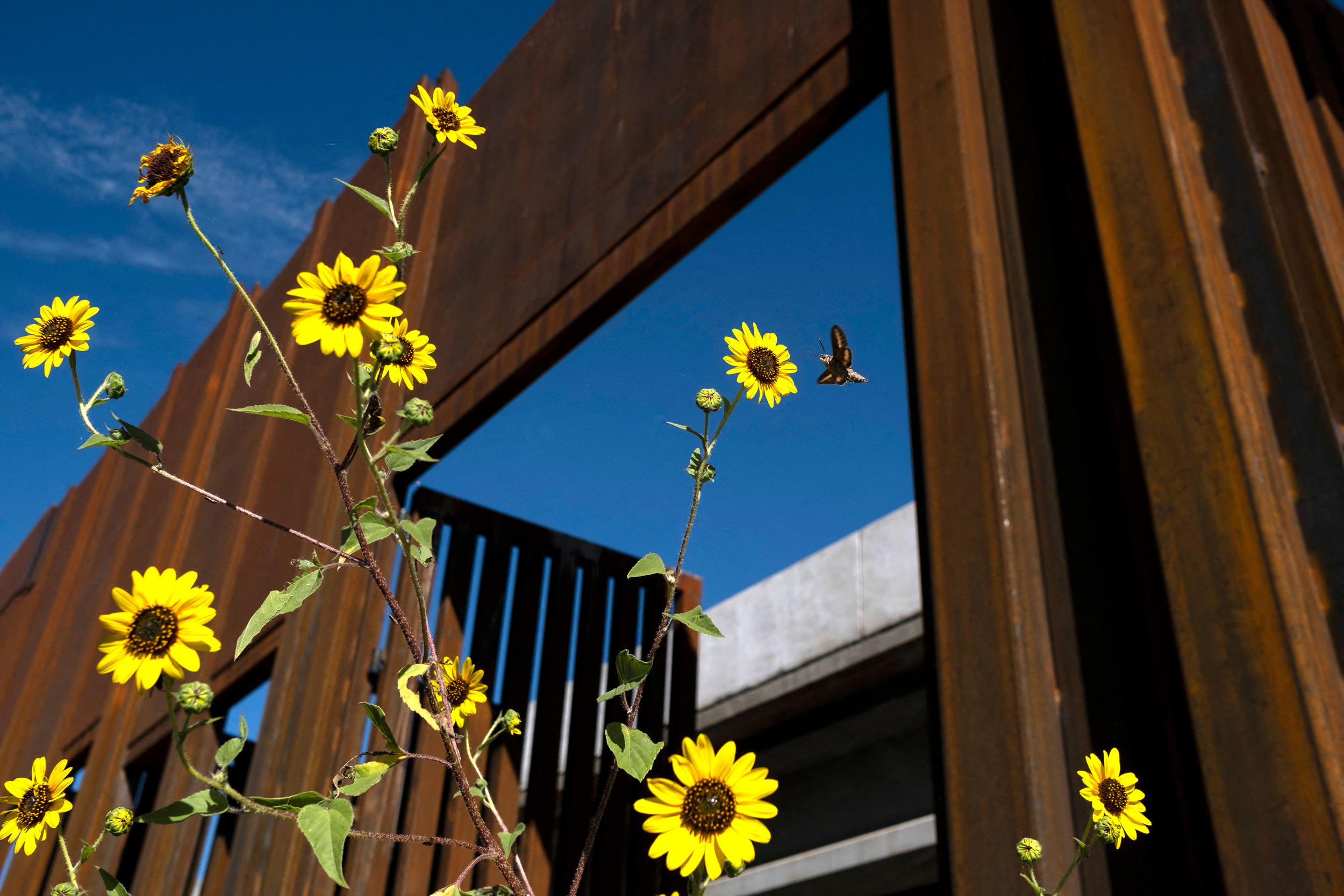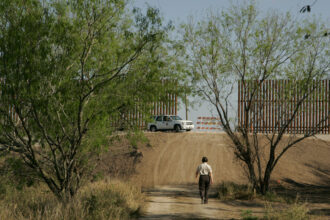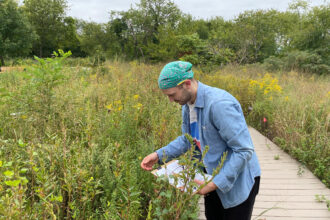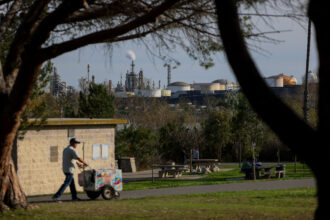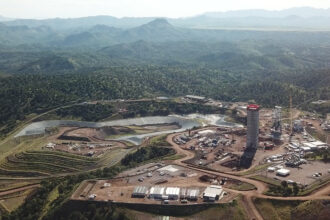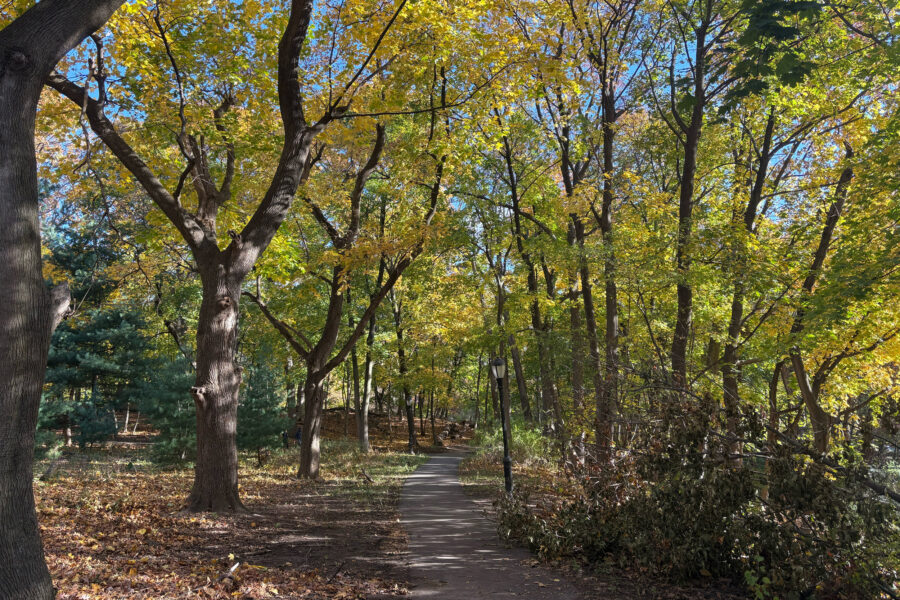It was a balmy day in Del Rio, a Texas border town about 170 miles west of San Antonio, when a citizen conservationist looking for wildlife stumbled upon a striking rust and orange caterpillar with fleshy horn-like protrusions that are meant to scare predators.
Eventually this larva would become the pipevine swallowtail, an eye-catching butterfly that features black, blue, white and orange hues and feeds on a number of native plants including milkweed.
The glimpse of the caterpillar helped boost the pollinator count in the richly biodiverse region where volunteers and scientists are increasingly trying to gauge whether federal efforts to build migrant barriers could be harming the natural life.
Most worrying to the environmentalists is the planned expansion of a federally-funded wall-in-progress at the U.S.-Mexico border, slabs of which were built during the first Trump administration. Early research has shown the walls can stop or deter the migration of pivotal pollinators and that is risky, conservationists caution.
“These are some of the most important areas for native pollinators, both bees and butterflies, as well as a whole suite of other native mammals and amphibians and reptiles and all sorts of things,” said Scott Black, executive director of the Xerces Society for Invertebrate Conservation, an international nonprofit that supports science-based long-term conservancy and has expressed concerns about the impacts of the border wall on wildlife.
The desert landscape that stretches across southern California, New Mexico, Texas, Arizona and northern Mexico is home to an array of pollinators including moths, flies, bats, hummingbirds and terrestrial seed dispersers like desert tortoises.
Among the challenges for native pollinators: habitat destruction and the walls themselves, which sometimes prevent flying insects from crossing.
Plans by the Trump administration for miles of new barriers—and most notably miles of harsh stadium lighting that would confuse all sorts of wildlife—could worsen the situation, environmentalists warn.
During President Trump’s first term there were 73 miles of new wall and secondary wall built where no barriers previously existed, according to government records then, and about 365 miles of outdated or dilapidated fencing replaced or fixed along the border.
President Biden’s administration in August 2023 approved plans for another 20 miles in Texas, according to a border patrol update. Opponents of the barrier were highly critical, noting Biden had campaigned against the wall while running for president.
The 1,954 mile-long borderland between the U.S. and Mexico is often regarded as barren borderland but it contains several highly biodiverse regions for hundreds of mammals, birds and insects.
The Lower Rio Grande Valley in Texas alone hosts around 1,200 plant species and nearly 300 butterfly species. The San Bernardino Valley, which straddles the border of southeastern Arizona and Sonora, Mexico, offers another bounty. Researchers recently discovered a six-square mile stretch of desert that is home to nearly 500 bee species, one of the highest known concentrations of bees in the world.
Some pollinators have exclusive relationships with certain plants, meaning if they don’t pollinate them, nothing else will. This is the case for a number of solitary bees, which often specialize in one plant species, according to Russ McSpadden, the Southwest conservation advocate for the nonprofit Center for Biological Diversity.
The monarch butterfly, whose caterpillars feed only on the milkweed that the butterflies pollinate, is currently under consideration for the federal Endangered Species List and relies on the borderlands region as a vital migratory corridor and breeding habitat.
Globally, many pollinator species are declining due to threats like habitat destruction and fragmentation, climate change and pesticides. Already, more than 70 pollinating species are listed as endangered or threatened in the United States, according to the Fish and Wildlife Service.
A recent U.S.-based study found that one in five native pollinators in North America are at elevated risk of extinction and cited the Southwest as home to the highest concentrations of at-risk species. The leading threat is from climate-related stressors, it said. Evidence “is limited” on pollinator activity, the study noted, and “standardized, long-term, and geographically broad monitoring data” is needed. “Knowing which species are declining, where they occur, and why they are declining is critical for focusing management interventions where they will most benefit at-risk species.”
That dearth of information is among the factors that drive citizen groups to try to keep track of—and count—the species in the borderlands.
“Not Just a Wall”
More than 100 miles of new border wall and waterborne barriers are currently funded by the federal government, with projects located in the U.S. Border Patrol’s San Diego, Yuma, Tucson, El Paso and Rio Grande Valley sectors, according to U.S. Customs and Border Protection. These projects are in various stages of planning and construction.
Border infrastructure is variable and includes bollard steel structures that rise 18 to 30 feet; concrete levee wall with steel bollards; legacy pedestrian fencing such as chain link or mesh; temporary barriers such as concertina and razor wire; and X-shaped steel obstacles known as Normandy barriers.
The expansion of the barriers has generated worry over big mammals such as jaguars and the impact on their migration patterns, but new tracts of wall will harm pollinators and native plants, said Black, an ecologist who has authored dozens of papers on invertebrates.
“This is a lot of habitat that will be lost,” Black said. “It’s not like you’ve got a wall and then you’ve got habitat on each side of the wall. This [land] is cleared because they want to see if people are jumping over. So there’s roads, they clear vegetation. It’s not just a wall.”
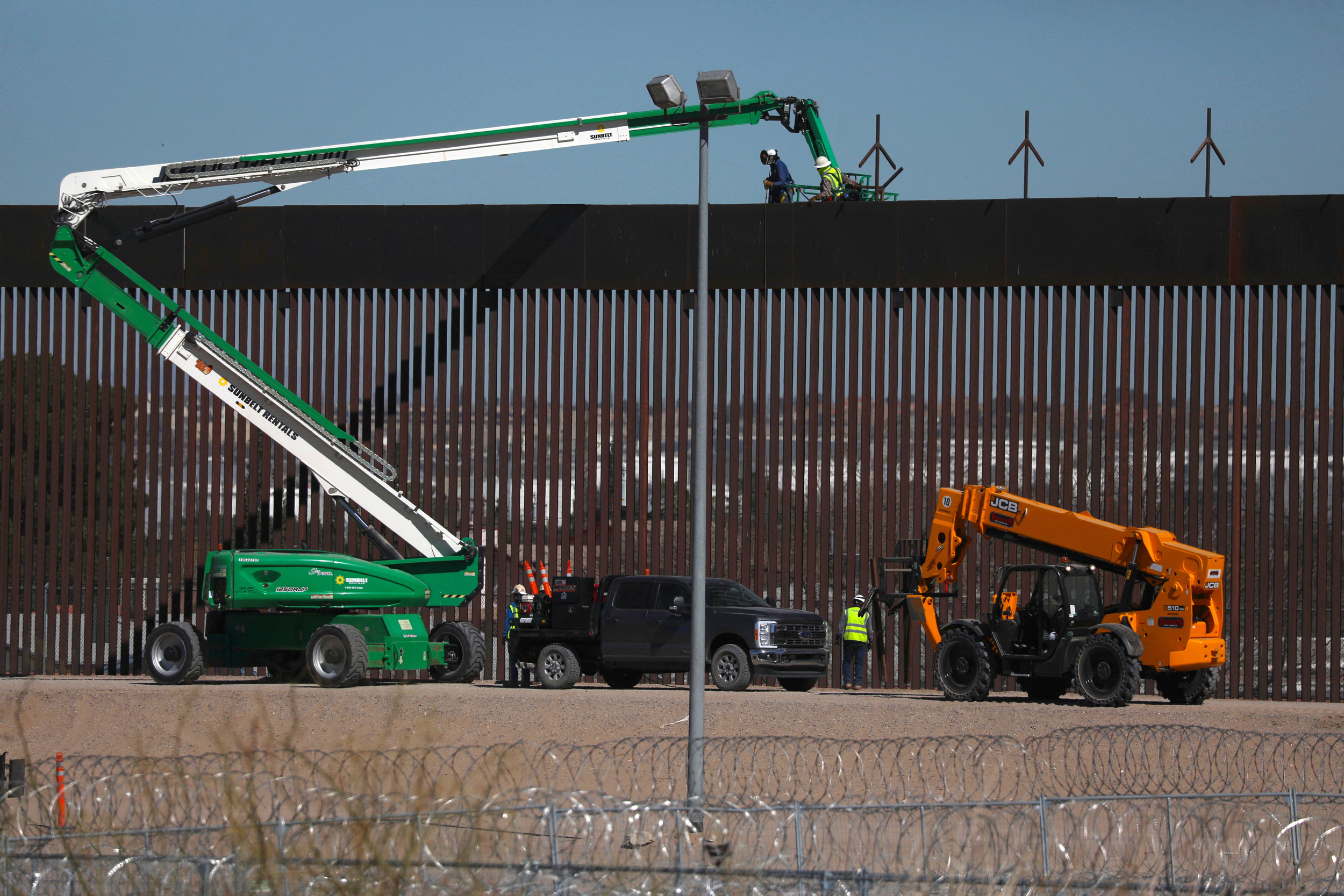
He added that “many thousands of acres of native habitat” have been or will be destroyed to build the wall and provide the infrastructure needed for management and patrols.
The physical structures may play a role in limiting some critical cross-border movement—even if the tiny travelers have wings to fly over the barriers.
According to a May study from the U.S. Geological Survey (USGS), researchers observed bees, butterflies, moths and wasps in South Texas, along the Rio Grande, for four months in 2023 and 2024 and documented some flight disruptions of the pollinators.
Bees flew over the barriers. Most butterflies were able to cross but 7 percent of them retreated or flew parallel to the wall, the study found. Moths were observed crawling through the slats of the wall and 20 percent did not cross but flew parallel to the barrier. Wind and temperature affected some flight distances, but the study found that border walls raised the potential for “limitations for pollinators moving across this landscape.”
More research was needed to consider “the deleterious effects on plant biodiversity in both natural and crop vegetation,” author Beth A. Middleton concluded, but she noted that conservationists could anticipate new challenges and possibilities at the border.
“The scope of this study was too limited to support any concerns for genetic flow disruption for endangered plant species populations,” she wrote. But the USGS study could be helpful in planning. “Because pollinators support endangered plant species, strategies to facilitate their barrier crossing could support plant conservation in South Texas,” according to the study.
Black Paint, Bright Lights
Scientists have also raised concerns that the border barriers—because of their size and dimensions—could block the movement of non-flying pollinators, the sort of crawling fauna that help spread seeds through daily wanderings.
“Desert tortoises can’t make their way across the bollards and they’re incredible seed dispersers,” McSpadden of the Center for Biological Diversity said, explaining that they eat prickly pear cactus, which account for several endangered subspecies. After munching on cacti, the tortoises expel the seeds as they crawl “and that’s one way those plants get distributed and maintain healthy populations,” he said.
McSpadden also noted the potential effects of more construction and a new Trump administration initiative to paint the barriers black.
This story is funded by readers like you.
Our nonprofit newsroom provides award-winning climate coverage free of charge and advertising. We rely on donations from readers like you to keep going. Please donate now to support our work.
Donate NowBlack paint draws in heat. The administration believes by raising the temperature of the wall itself that people will be deterred from climbing. But the heat could also injure pollinators that crawl through the slats or rest on the wall’s surface, McSpadden said.
The construction itself is a risk, added McSpadden, who toured a number of areas where border walls were built during President Trump’s first term. The San Bernardino National Wildlife Refuge, located in Arizona’s biodiverse San Bernardino Valley, had no internal roads before the border wall was built during the first Trump administration, he said.
“When you go out there now, there are these 20-foot-wide dirt roads, and people use them. If you build a road, people will use them,” McSpadden said, adding that research has linked roadways to pollinator risk. A 2021 study in Michigan found that roadways block bee movement and reduce pollen transfer. Vehicle strikes also significantly threaten bees, a study in Utah in 2024 concluded.
Stadium lights used to surveil the wall have also been a worry for years, though much of the lighting has yet to be turned on because of pending environmental assessments, McSpadden said.
Federal contractors erected more than 1,800 stadium lights between 2019 and 2021, according to a 2023 Center for Biological Diversity report led by McSpadden, which inventoried border lighting in conservation lands along the southern edge of Arizona. This included 740 stadium lights across nearly 25 miles within Organ Pipe Cactus National Monument and 500 lights across about 17 miles of the San Bernardino Valley. The only lights that have been turned on so far are those near ports of entry, according to McSpadden.
Lighting affects each pollinator differently. “Studies show that in general, artificial lights will either attract or push away insects,” McSpadden said. “And both can be really problematic.”
Moths, for instance, may become attracted to a light on the wall, making them more susceptible to predation and distracting them from pollination, he explained. Other insects may be repelled by the light. “In the Sonoran Desert, we’re also really concerned about bats, which are almost overwhelmingly disoriented, to say the least, by lighting.”
The borderlands region of southern Arizona and northern Mexico is known for its diversity of bat species, including at least 14 within Organ Pipe Cactus National Monument. Lesser long-nosed bats are the principal pollinators of both saguaro and organ pipe cactuses.
The bats’ feeding, roosting and navigation are affected by artificial lights, according to the Center’s report. “Some species change their behavior to hunt insects attracted to artificial lights and become exposed to predators. Other bats avoid lights and avoid feeding and watering sites within lighted areas.”
Scant Research Funds
Despite their concerns, McSpadden and Black admit there is little research about how the border wall is affecting pollinators. Black points to the fact that much of the infrastructure is relatively new and funding for such research in the United States is meager. McSpadden pointed to research about similar land barriers in other parts of the world, such as one 2003 study that suggested that one section of the Great Wall of China has restricted the gene flow of insect-pollinated plants separated for more than 600 years.
Black said the dearth of data should not deter federal planners or even residents in the region from respecting and protecting what is now there. For instance, revegetating areas on either side of the border with native plants after a barrier’s construction could help with habitat loss. The wall design itself could be adjusted, he said, so that slats allow butterflies and moths to move through more easily.
Homeowners too can make a difference, he added. Their backyards can help by creating habitat and limiting the use of pesticides, Black added. “Anybody, whether they have a little yard or farm or manage a giant swath of land, can be part” of an effort to protect the pollinators, he said.
About This Story
Perhaps you noticed: This story, like all the news we publish, is free to read. That’s because Inside Climate News is a 501c3 nonprofit organization. We do not charge a subscription fee, lock our news behind a paywall, or clutter our website with ads. We make our news on climate and the environment freely available to you and anyone who wants it.
That’s not all. We also share our news for free with scores of other media organizations around the country. Many of them can’t afford to do environmental journalism of their own. We’ve built bureaus from coast to coast to report local stories, collaborate with local newsrooms and co-publish articles so that this vital work is shared as widely as possible.
Two of us launched ICN in 2007. Six years later we earned a Pulitzer Prize for National Reporting, and now we run the oldest and largest dedicated climate newsroom in the nation. We tell the story in all its complexity. We hold polluters accountable. We expose environmental injustice. We debunk misinformation. We scrutinize solutions and inspire action.
Donations from readers like you fund every aspect of what we do. If you don’t already, will you support our ongoing work, our reporting on the biggest crisis facing our planet, and help us reach even more readers in more places?
Please take a moment to make a tax-deductible donation. Every one of them makes a difference.
Thank you,

